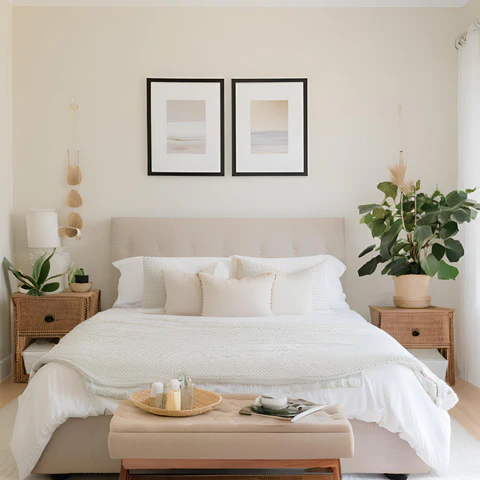Blog
How to Design a Bedroom That Promotes Relaxation
Your bedroom should be a sanctuary—a place where you can unwind, recharge, and escape the stress of daily life. A well-designed bedroom that promotes relaxation goes beyond just aesthetics; it incorporates elements that support comfort, tranquility, and a calming atmosphere. Whether you’re designing a new bedroom or reworking your existing space, the following tips will guide you in creating a serene environment that encourages restful sleep and relaxation.

1. Choose Soothing Colors for Your Walls
The colors you choose for your bedroom have a significant impact on your mood and relaxation. Calm, soft colors create a peaceful environment conducive to rest.
- Soft Neutrals: Light colors like beige, ivory, and soft gray are perfect for creating a soothing ambiance. These neutral shades make the room feel calm and spacious, promoting relaxation.
- Cool Blues and Greens: Shades of blue and green are known to have a calming effect on the mind. Light blue evokes a sense of tranquility, while green is associated with nature and balance. These hues are ideal for a bedroom designed to promote relaxation.
- Warm, Earthy Tones: If you prefer a cozier feel, earthy tones such as warm taupe, soft terracotta, or muted browns can provide comfort and relaxation without overwhelming the senses.
Tip: Avoid bright or overly saturated colors, such as red or orange, as these can be energizing and may interfere with a relaxing atmosphere.
2. Invest in Comfortable Bedding
A restful sleep environment is essential for relaxation, and it all starts with comfortable bedding. High-quality sheets, blankets, and pillows will not only enhance the look of your bedroom but also contribute to your overall comfort and quality of sleep.
- Soft, Breathable Fabrics: Opt for natural, breathable fabrics like cotton, linen, or bamboo. These materials are soft to the touch and help regulate temperature, ensuring you stay comfortable throughout the night.
- Layered Bedding: Create a cozy, inviting atmosphere with layered bedding. Add plush comforters, throws, and pillows to make your bed feel like a luxurious retreat. Choose soft textures like velvet or down for added warmth and comfort.
- Invest in a Good Mattress: A comfortable mattress is essential for a good night’s sleep. Choose one that suits your sleeping preferences—whether it’s memory foam, innerspring, or hybrid—so that you wake up feeling rested and rejuvenated.
Tip: Choose calming, neutral tones for your bedding to complement the relaxing atmosphere you’re aiming for in your bedroom.
3. Prioritize Lighting for Ambiance
Lighting is one of the most important factors in creating a relaxing bedroom. Soft, adjustable lighting can help you unwind and set the mood for relaxation.
- Ambient Lighting: Use soft, diffused lighting to create a calm and inviting atmosphere. Overhead lights with dimmer switches or soft pendant lights are great options for providing gentle illumination.
- Task Lighting: Add bedside table lamps or wall sconces for reading or other tasks. These should offer enough light without being too harsh. Lamps with adjustable brightness levels are ideal, allowing you to customize the light to your needs.
- Accent Lighting: Incorporate accent lighting like string lights, fairy lights, or candles to add warmth and a soft glow. These lights can create a tranquil, cozy vibe perfect for winding down.
- Natural Light: Whenever possible, incorporate natural light into your bedroom design. Sunlight during the day has a positive impact on mood and can help regulate your sleep cycle. Use light, airy curtains or blinds to let in the light while maintaining privacy.
Tip: Avoid harsh, bright lighting, as it can create an overstimulating environment. Stick to soft, warm lighting for a relaxed, peaceful atmosphere.
4. Declutter for a Calming Environment
A cluttered bedroom can lead to a stressed mind, making it difficult to relax and unwind. Keeping your bedroom tidy and organized is key to creating a peaceful space.
- Storage Solutions: Invest in stylish storage options such as under-bed storage, dressers with plenty of drawers, or decorative baskets to keep things organized. When your room is clutter-free, you’ll feel more at ease.
- Minimalist Approach: Take a minimalist approach to furniture and decor. Choose only essential items that contribute to the function and beauty of the room. Avoid overcrowding the space with unnecessary decor or furniture.
- Organized Nightstands: Keep your nightstand tidy with only the essentials—such as a lamp, clock, or a book. An organized nightstand promotes a calming atmosphere before bedtime.
Tip: Regularly declutter and keep only items that make you feel relaxed and comfortable. A clean, organized space will encourage a peaceful, restful environment.
5. Incorporate Natural Elements
Bringing nature into your bedroom can have a calming and grounding effect. Natural materials and elements can add beauty, tranquility, and serenity to your space.
- Indoor Plants: Adding plants to your bedroom can help purify the air and provide a sense of connection with nature. Consider low-maintenance plants like snake plants, peace lilies, or succulents, which are perfect for bedrooms.
- Wooden Elements: Incorporate wood into your furniture, flooring, or decor. Natural wood finishes in furniture or a wooden headboard can create a warm, earthy atmosphere. Wood is known for its calming properties and adds a cozy, grounded feel to the room.
- Natural Textures: Choose natural textures like linen, cotton, and wool for bedding, curtains, and furniture. These materials evoke a sense of comfort and simplicity, ideal for a bedroom designed for relaxation.
Tip: Avoid too many synthetic materials, as they can detract from the calming, natural vibe you’re aiming for.
6. Create a Cozy, Inviting Space with Textures
The textures in your bedroom contribute to its overall feel and comfort. Layering different textures creates a warm, inviting, and comfortable environment.
- Soft Rugs: Add a soft rug to your bedroom floor, especially near the bed, so your feet can land on something warm and cozy when you get up in the morning or before bed. Choose plush, textured rugs in neutral tones or calming patterns.
- Throw Blankets and Pillows: Layer soft throws and decorative pillows on the bed or seating areas. Mix and match different textures like knitted throws, velvet pillows, and soft linen cushions to create a cozy atmosphere.
- Curtains and Drapes: Choose soft, flowing curtains made from natural fabrics like cotton or linen. These materials create a relaxed, airy atmosphere and allow light to filter into the room gently.
Tip: The goal is to create a tactile experience that enhances comfort and relaxation. Avoid heavy, stiff textures that could create an uncomfortable environment.
7. Use Calming Scents for Relaxation
Aromatherapy can play a powerful role in promoting relaxation and enhancing your sleep quality. Adding calming scents to your bedroom can help set the mood for rest.
- Essential Oils: Use a diffuser with calming essential oils like lavender, chamomile, or sandalwood. These scents are known for their ability to reduce stress, calm the mind, and promote relaxation.
- Candles: Scented candles can also add a relaxing fragrance to your bedroom while providing soft lighting. Opt for natural, non-toxic candles with essential oils for the best results.
- Scented Linen Spray: Mist your bedding and curtains with a soothing linen spray before bed. This adds a calming scent to your room and enhances the overall sleep experience.
Tip: Stick to subtle scents that won’t overwhelm the senses. Overpowering fragrances can have the opposite effect and may make it harder to unwind.
8. Incorporate Personal Touches
Adding personal elements to your bedroom will make it feel more like a sanctuary and provide a sense of calm and familiarity.
- Personal Artwork: Hang artwork that makes you feel calm and happy, whether it’s nature-inspired prints, abstract art, or family photos. Choose pieces that evoke a sense of peace and joy.
- Meaningful Objects: Incorporate personal items that hold meaning, such as a favorite book, a sentimental piece of jewelry, or a cherished memento. These objects can help you feel more connected to your space.
Tip: Be selective with the items you include. Too many personal items can create clutter, but a few meaningful pieces can help create a relaxed, comforting atmosphere.

Conclusion
Designing a bedroom that promotes relaxation involves more than just choosing stylish decor. It’s about creating an environment that nurtures comfort, tranquility, and a sense of calm. By focusing on soothing colors, comfortable bedding, soft lighting, organized spaces, natural elements, and personal touches, you can create a sanctuary that encourages restful sleep and relaxation. With a few thoughtful changes, your bedroom can become the ultimate retreat for unwinding after a long day.


